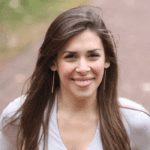Create Mobility in the Upper Body With Puppy Pose Yoga 2.0

Puppy Pose, also known as Uttana Shishosana or sometimes called Anahatasana, is a great release for the latissimus dorsi, posterior deltoids, pectorals, triceps, abdominal muscles, and more.
It’s somewhat of a cross between Downward Facing Dog Pose (Adho Mukha Svanasana) and Child’s Pose (Balasana)—seemingly as gentle as Child’s Pose but also as active as Downward Facing Dog to offer the perfect balance between stretch and relaxation.
There are many variations that you could play with in Puppy Pose to provide wonderful benefits. Still, this variation of Uttana Shishosana offers a deep release into the thoracic spine (the middle and upper back) as well as the shoulders and the upper arms to soften the front side of the body and help to prepare for deeper backbending poses.
Try This Blocked Variation of Uttana Shishosana to Create Space in Your Shoulders and Upper Back
For this variation of Uttana Shishosana, you’ll need at least two yoga blocks. You may also wish to have a blanket or cushion to place beneath your knees for extra padding and any other props you’d like for support beneath your torso or head.
- Start on all fours in a neutral Tabletop Pose (Bharmanasana) with your shoulders roughly aligned over your wrists and your hips roughly aligned over your knees. Option to place padding underneath your knees.
- Place your two yoga blocks on their lowest- or medium-height setting underneath your hands, roughly shoulders-distance apart and parallel to the long edges of your mat.
- Walk your blocks and your hands slightly forward in front of you so that they’re just forward of your shoulders.
- Release your elbows onto your blocks and slide your elbows forward toward the top of your mat so they rest on the very edges of your blocks.

- Keep your hips where they are (roughly aligned over your knees) and melt the weight of your chest toward the floor to create a subtle arch into your whole back body while specifically targeting the arch into your upper back.
- If you’d like, you can draw your palms to meet in front of you in a prayer position. Then bend into your elbows and either reach your fingers to face up toward the ceiling or draw your thumbs back toward the nape of your neck to deepen the stretch in the backs of your arms.
- Soften the weight of your front body toward the floor as you lengthen it. And soften into your armpits as they lengthen forward and down toward the floor.
- You may wish to rest your chin or forehead on a prop or the floor. You may also wish to slide a bolster, cushion, or pillow beneath your whole torso and/or underneath your forehead.
- Draw your shoulder blades toward each other as you broaden across your chest and melt your heart downward.
- Soften and hold as you breathe deeply for about five to 10 full breaths.
- When you’re ready to release, gently extend through your arms if you bent them and then slowly root down against your elbows to lift the weight of your chest up away from the floor.
- Place your hands onto your blocks and rise back up to Tabletop Pose, where you started on all fours.
- Pause for a moment to take notice of any subtle changes in your body, breath, or mind.
- If you’d like, you may wish to repeat this a few more times to really open across your front body and shoulders and help prepare you for deeper backbends.
Use Puppy Pose (Uttana Shishosana) to Create Mobility and Freedom in Your Upper Body and Prepare for Deeper Backbends
 Puppy Pose is a gentle backbending posture that offers the perfect release to prepare your body for deeper backbends.
Puppy Pose is a gentle backbending posture that offers the perfect release to prepare your body for deeper backbends.
This particular variation offers an optimal opening for your shoulders, upper back, and specifically your latissimus dorsi (the broad muscle reaching from the top of your pelvis all the way up your back to attach to your upper arm) and your triceps (the muscles on the back of your upper arms).
As you stretch and release all these areas and muscle groups, you may find a greater range of motion in your upper body to feel a sense of mobility and freedom.
Also, read...
4 Easy Ways to Use a Sandbag in Yoga Practice
Exercise and Longevity: Diversify Your Yoga Practice for Maximum Benefits
Glute Amnesia: Yoga for Your Forgotten Rear
Related courses
Breath as Medicine: Yogic Breathing for Vital Aging
Yoga and Myofascial Release: Releasing Chronic Tension with the Bodymind Ballwork Method

Leah Sugerman is a yoga teacher, writer, and passionate world traveler. An eternally grateful student, she has trained in countless schools and traditions of the practice. She teaches a fusion of the styles she has studied with a strong emphasis on breath, alignment, and anatomical integrity. Leah teaches workshops, retreats, and trainings, both internationally and online. For more information, visit www.leahsugerman.com.



